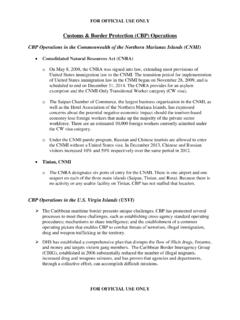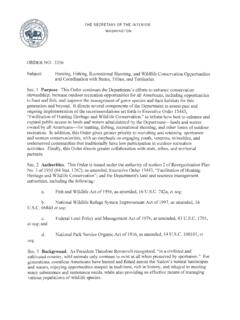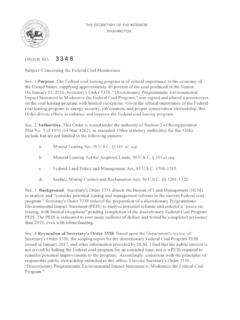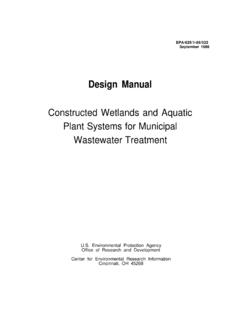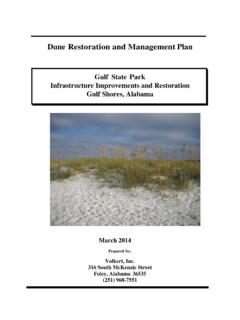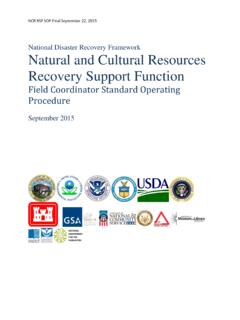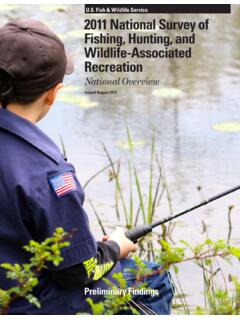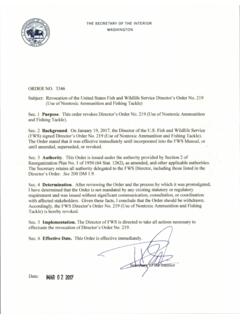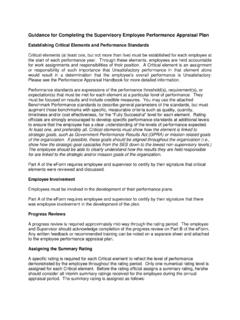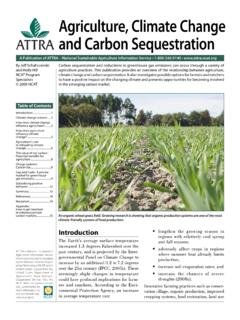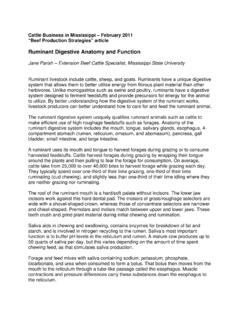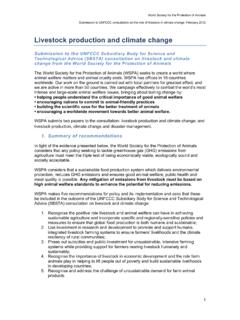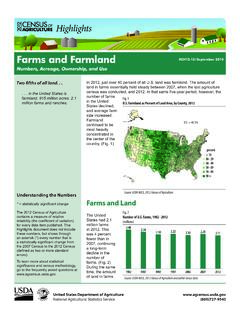Transcription of Invasive Species Definition Clarification and Guidance
1 1 Invasive Species Definition Clarification and GuidanceApproved by isac on April 27, 2006 Submitted by the Definitions Subcommittee of the Invasive Species Advisory Committee (isac) PREAMBLEE xecutive Order 13112 defines an Invasive Species as an alien Species whose introduction does or is likely to cause economic or environmental harm or harm to human health. In the Executive Summary of the National Invasive Species Man-agement Plan the term Invasive Species is further clarified and defined as a Species that is non-native to the ecosys-tem under consideration and whose introduction causes or is likely to cause economic or environmental harm or harm to human health.
2 To provide Guidance for the development and implementation of the Management Plan, the National Invasive Species Council (nisc) and the Invasive Species Ad-visory Committee (isac) adopted a set of principles outlined in Appendix 6 of the Management Plan. Guiding Principle 1 provides additional context for defining the term Invasive Species and states many alien Species are non- Invasive and support human livelihoods or a preferred quality of life. How-ever, some alien Species (the term non-native will be used in this white paper because it is more descriptive than alien), for example West Nile virus, are considered Invasive and un-desirable by virtually everyone.
3 Other non-native Species are not as easily characterized. For example, some non-native Species are considered harmful, and therefore, Invasive by some sectors of our society while others consider them ben-eficial. This discontinuity is reflective of the different value systems operating in our free society, and contributes to the complexity of defining the term Invasive is engaged in evaluating and updating the 2001 Management Plan and is developing comments for a revised action plan as required by the 13112.
4 While there have been numerous attempts to clarify the term Invasive Species , there continues to be uncertainty concerning the use and perceived meaning of the term, and consequently over the prospective scope of actions proposed in the Management Plan. Options related to private property use, pet ownership, agriculture, horticulture, and aquaculture enterprises may be affected depending upon the Definition , use, and policy implications of the particular, the desire to consider a non-native Species as Invasive may trigger a risk/benefit assessment process to determine whether regulatory action is warranted.
5 All these uncertainties have stood and could continue to stand in the way of progress in actions and policy development to prevent new invasions and manage existing Invasive Species . While it is not the purpose of this white paper to define a risk/benefit assessment process, development of such a process must be open and efficient to minimize the uncertainties. This white paper is intended to provide a non-regulatory policy interpretation of the term Invasive Species by identify-ing what is meant, and just as important, what is not meant Weeds as Examples Weeds provide good examples to clarify what is meant by an Invasive Species because most people have a concept of what constitutes a weed.
6 Invasion can be thought of as a process that in our ex-ample, a plant must go through to become a successful, yet harmful invader. Several barriers must be overcome for a plant to be considered an Invasive weed. Invasive weeds are Invasive Species . large-scale geographical barriers First, a geographical barrier first must be overcome, which often occurs as a mountain range, ocean, or similar phys-ical barrier to movement of seeds and other reproductive plant parts. Plants that overcome geographical barriers are known as alien plants or alien Species .
7 Alien plants are non-native plants and alien Species are non-native Species . Therefore, non-native plants are those that occur outside their natural range boundaries, and this most often is me-diated by humans either deliberately or unintentionally. survival barriersThe second set of obstacles that a non-native plant must overcome is barriers to germination and survival in its new location. These typically are environmental barriers such as adequate moisture availability to allow successful germination and survival of seedlings that will continue to grow to maturity.
8 Other physical barriers might be soil pH, nutrient availability, or competition for resources from neighboring Department of the InteriorO ce of the Secretary C Street Washington, DC 2 Invasive Species advisory committee, april 2006invasive Species Definition and Clarification Guidance 3by the term. isac recognizes that biological and ecological definitions will not precisely apply to regulatory definitions. We believe, however, that our Clarification will apply to all taxa of Invasive Species in all habitats and furthermore, our explanation will be functional and acceptable to most stake-holders.
9 Isac simply wants to clarify what is meant and what is not meant by the term Invasive Species in the technical sense and to provide insight into those areas where societal judgments will be necessary to implement effective public policy. The utility of our Clarification should be in education, con-flict resolution, and efficiency in the planning, prevention, control/eradication, and management of Invasive Species . isac recommends that nisc adopt the clarifications presented in this white paper to foster progress for Invasive Species management in the United States.
10 INTRODUCTIONAn Invasive Species is a non-native Species whose introduc-tion does or is likely to cause economic or environmental harm or harm to human, animal, or plant health. The National Invasive Species Management Plan indicates that nisc will focus on non-native organisms known to cause or likely to cause negative impacts and that do not provide an equivalent or greater benefit to society. In the technical sense, the term invasion simply denotes the uncontrolled or unintended spread of an organism outside its native range with no specific reference about the environmental or economic consequences of such spread or their relationships to possible societal bene-fits.
